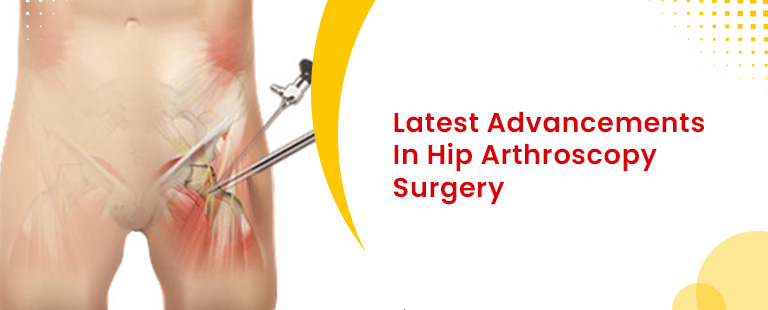Latest Advancements in Hip Arthroscopy Surgery
Hip arthroscopy is not just a solution for joint issues but is a revolutionary change. With tiny cuts and special tools, it is less invasive, and the recovery is much quicker and less painful. This method stands out due to its precision and enables personalized patient care.
Advancements in imaging technologies are revolutionizing how surgeons understand the hip joint, allowing for personalized treatment plans. The continuous innovation in hip arthroscopy makes the entire process smarter and more effective with each breakthrough.
In this blog, we discuss the latest advancements in hip arthroscopic surgery.
Minimally Invasive Techniques
Modern surgery often involves using minimally invasive techniques.
With smaller incisions and advanced instruments, patients experience reduced pain, shorter recovery times, less scarring, and improved overall outcomes. These days, traditional open surgery is making way for minimally invasive surgeries.
Arthroscopic procedures involve smaller incisions through which a tiny camera (arthroscope) and specialized instruments are inserted. This reduces trauma to surrounding tissues and allows for a quicker return to normal activities.
Advancements in arthroscopic instruments have enhanced these techniques. High-definition cameras provide crystal-clear visuals, and miniature tools designed for delicate procedures contribute to the overall success of the surgery. Patients undergoing minimally invasive hip arthroscopy report less discomfort, shorter hospital stays, and faster rehabilitation than those undergoing traditional open surgeries.
Advancements in Imaging Technology
Accurately visualizing intricate joint details is important for the success of hip arthroscopy. Recent advances in imaging technology have significantly elevated this aspect of the procedure.
The introduction of 3D arthroscopy has been a game-changer, providing surgeons with a three-dimensional view of the hip joint. This technology helps surgeons visualize the body’s structures better, making it easier to figure out problems and do precise treatments.
Augmented reality goes a step further by adding digital information directly to what the surgeon sees during the operation. Picture a surgeon being guided by virtual markers and cues, making everything more accurate than before.
These technologies enhance the surgeon’s ability to understand the complexities of the hip joint and improve patient outcomes. The more precise the diagnosis, the more tailored the treatment plan, leading to a higher likelihood of successful recovery.
Personalized Treatment Plans
With the latest technological advancements, it is now possible to do hip arthroscopy with a more customized and patient-centric approach.
For instance, patient-specific implants are designed using advanced imaging and 3D printing technologies. This ensures a perfect fit for each individual’s unique anatomy and improves the overall functionality of the joint post-surgery. It also minimizes the risk of complications associated with ill-fitting implants.
Not only are personalized implants used, but rehabilitation plans are also customized. Physiotherapy programs now consider factors like age, fitness, and lifestyle to ensure the recovery process matches the patient’s unique situation. This personalized approach helps in the overall recovery of the patients.
Robotics and Artificial Intelligence
In hip arthroscopy, using robots and artificial intelligence helps surgeons study, diagnose, and do treatments more accurately. Robotic-assisted surgeries offer great accuracy.
Surgeons can accurately control robotic arms, making precise movements inside the patient’s body. This high level of control is especially beneficial in delicate procedures like hip arthroscopy, where precision is crucial.
AI helps with decisions during surgery and taking care of patients post-surgery. Machine learning algorithms analyze lots of data to find patterns, helping surgeons make smart choices. After surgery, AI monitoring systems track the progress of the patient and notify healthcare providers if there are any unexpected changes in recovery.
Robotics and AI working together improve hip arthroscopy, offering better results and a peek into the future of surgery.
Treating Complex Hip Conditions
Hip arthroscopy doesn’t just handle basic problems but can also deal with complicated issues that were once seen as very challenging. Conditions like femoroacetabular impingement (FAI) and labral tears, which were considered hard to treat, are now approached with more hope.
Advanced tools and techniques are playing a pivotal role in addressing these complexities. For FAI, precise instruments and imaging technologies help surgeons reshape the hip joint accurately, easing impingement and bringing back normal function. Labral tears used to be treated conservatively or with open surgeries are now repaired with arthroscopic precision, causing less harm to nearby tissues.
Additionally, regenerative medicine, like platelet-rich plasma (PRP) therapy and stem cell treatments, broadens treatment options. These therapies support tissue healing and regeneration, providing a comprehensive approach to managing complex hip conditions.
Summary:
With the advancement in medical technology, orthopedic medicine is going through a massive transformation. From using precise imaging to making personalized care plans, the journey has been about finding new and better ways to help patients.
By analyzing the latest advancements, we can understand that hip arthroscopy is not just a surgical procedure but a tailored experience to restore mobility, alleviate pain, and enhance overall quality of life.


